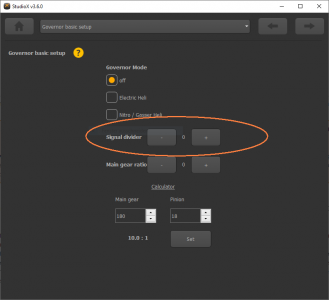Manuals:BXFbl:Governormenu E/de: Difference between revisions
Shornstein (talk | contribs) Created page with "{{TOC_BXFbl/de|Manuals:BXFbl:Governormenu_D/de|Manuals:BXFbl:Governormenu_F/de|GOVMENU|}} __TOC__ <br />" Tags: Mobile edit Mobile web edit |
Shornstein (talk | contribs) Created page with "'''Elektromodell''': Der Phasensensor oder Drehzahlsteller gibt üblicherweise die elektrische Felddrehzahl aus und nicht die tatsächliche Motordrehzahl. Um die tatsächliche Motordrehzahl zu erhalten, muss die Felddrehzahl anhand der Polzahl des Motors umgerechnet werden. '''Modelle mit Verbrennungsmotor''': Wenn ein Magnetsensor verbaut ist und mehr als ein Magnetgeber zur Messung der Drehzahl verwendet wird, so multipliziert sich die ausgegebene Drehzahl um die Anzah..." |
||
| Line 3: | Line 3: | ||
<br /> | <br /> | ||
'''Elektromodell''': Der Phasensensor oder Drehzahlsteller gibt üblicherweise die elektrische Felddrehzahl aus und nicht die tatsächliche Motordrehzahl. Um die tatsächliche Motordrehzahl zu erhalten, muss die Felddrehzahl anhand der Polzahl des Motors umgerechnet werden. | |||
'''Modelle mit Verbrennungsmotor''': Wenn ein Magnetsensor verbaut ist und mehr als ein Magnetgeber zur Messung der Drehzahl verwendet wird, so multipliziert sich die ausgegebene Drehzahl um die Anzahl der Magnete. Bei zwei Magneten wird der Sensor eine doppelt so hohe Drehzahl messen, als mit einem Magnet.<br /> | |||
<br /> | <br /> | ||
<div lang="en" dir="ltr" class="mw-content-ltr"> | <div lang="en" dir="ltr" class="mw-content-ltr"> | ||
Revision as of 14:41, 26 March 2025
Elektromodell: Der Phasensensor oder Drehzahlsteller gibt üblicherweise die elektrische Felddrehzahl aus und nicht die tatsächliche Motordrehzahl. Um die tatsächliche Motordrehzahl zu erhalten, muss die Felddrehzahl anhand der Polzahl des Motors umgerechnet werden.
Modelle mit Verbrennungsmotor: Wenn ein Magnetsensor verbaut ist und mehr als ein Magnetgeber zur Messung der Drehzahl verwendet wird, so multipliziert sich die ausgegebene Drehzahl um die Anzahl der Magnete. Bei zwei Magneten wird der Sensor eine doppelt so hohe Drehzahl messen, als mit einem Magnet.
For MICROBEAST PLUS Firmware 5.4.0 with Telemetry support this setting is also used for calculating the rotor speed that is displayed in your telemetry screen. Therefor it is not necessary to enable the GOVERNOR feature, of course you can use the internal governor of your ESC when using telemetry! Simply adjust the displayed rotor speed by changing the division factor for accounting the number of motor poles here.
The motor poles of an electric motor can be easily determined by counting the number of magnets built into the motor housing. Each magnet corresponds to one magnetic pole. Note that on some motors pairs of magnets are used rather than one single large magnet. These pairs together form just one magnetic pole! If in doubt refer to the datasheet of the motor or ask the manufacturer or your local dealer.
To determine the number of magnets that are used for a magnetic rpm sensor in a nitro helicopter, you can use the Sensor Test mode of GOVERNOR MENU (Menu point A). Each time a magnet passes the sensor the Status-LED will light up in blue color there, i.e. when you turn the clutch bell by hand. So you simply count how often the Status-LED lights up during one rotation. Then this is the divider you have to setup.
Adjustment on the device
At GOVERNOR MENU point E the currently selected division factor is represented by the color of the Status-LED. Use the rudder stick to switch between options.
| Status-LED | RPM Divider |
|---|---|
| off | no division 2 motor poles (electric) or 1 magnet (nitro) |
| purple flashing | 2 4 motor poles (electric) or 2 magnets (nitro) |
| purple | 3 6 motor poles |
| red flashing | 4 8 motor poles |
| red | 5 10 motor poles |
| blue flashing | 6 12 motor poles |
| blue | 7 14 motor poles |
Setup with StudioX
In StudioX simply enter the rpm divider using the push buttons.
